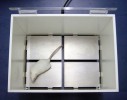Authors
V. Vialou, L. Balasse, J. Callebert, J.-M. Launay, B. Giros et al.
Lab
Inserm U513, Université Paris VI, Paris, France.
Journal
Journal of Neurochemistry
Abstract
Organic cation transporters (OCTs) are carrier-type polyspecific permeases known to participate in low-affinity extraneuronal catecholamine uptake in peripheral tissues. OCT3 is the OCT subtype most represented in the brain, yet its implication in central aminergic neurotransmission in vivo had not been directly demonstrated. In a detailed immunohistochemistry study, we show that OCT3 is expressed in aminergic pathways in the mouse brain, particularly in dopaminergic neurons of the substantia nigra compacta, non-aminergic neurons of the ventral tegmental area, substantia nigra reticulata (SNr), locus coeruleus, hippocampus and cortex. Although OCT3 was found mainly in neurons, it was also occasionally detected in astrocytes in the SNr, hippocampus and several hypothalamic nuclei. In agreement with this distribution, OCT3/Slc22a3-deficient mice show evidence of altered monoamine neurotransmission in the brain, with decreased intracellular content and increased turnover of aminergic transmitters. The behavioral characterization of these mutants reveal subtle behavioral alterations such as increased sensitivity to psychostimulants and increased levels of anxiety and stress. Altogether our data support a role of OCT3 in the homeostastic regulation of aminergic neurotransmission in the brain.
BIOSEB Instruments Used:
Aron Test or Four Plates Test (LE830),Rotarod (BX-ROD)

 Pain - Thermal Allodynia / Hyperalgesia
Pain - Thermal Allodynia / Hyperalgesia Pain - Spontaneous Pain - Postural Deficit
Pain - Spontaneous Pain - Postural Deficit Pain - Mechanical Allodynia / Hyperalgesia
Pain - Mechanical Allodynia / Hyperalgesia Learning/Memory - Attention - Addiction
Learning/Memory - Attention - Addiction Physiology & Respiratory Research
Physiology & Respiratory Research
 Pain
Pain Metabolism
Metabolism Motor control
Motor control Neurodegeneration
Neurodegeneration Cross-disciplinary subjects
Cross-disciplinary subjects Muscular system
Muscular system General activity
General activity Mood Disorders
Mood Disorders Other disorders
Other disorders Joints
Joints Central Nervous System (CNS)
Central Nervous System (CNS) Sensory system
Sensory system

